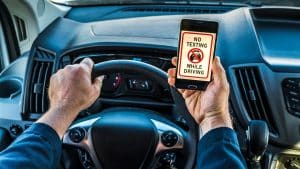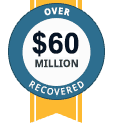New Technology To Help Reduce Distracted Driving
 Driving while distracted is a major cause of car accidents and truck accidents in Delaware. Driving while distracted includes texting while driving, using a smartphone while driving, eating or drinking while driving, and any activity that takes a driver’s eyes off the roads, hands off the wheel, and minds off of traffic. If you were in an accident with a distracted driver, call the injury attorneys at Silverman, McDonald & Friedman, located in Newark, Wilmington, and Seaford.
Driving while distracted is a major cause of car accidents and truck accidents in Delaware. Driving while distracted includes texting while driving, using a smartphone while driving, eating or drinking while driving, and any activity that takes a driver’s eyes off the roads, hands off the wheel, and minds off of traffic. If you were in an accident with a distracted driver, call the injury attorneys at Silverman, McDonald & Friedman, located in Newark, Wilmington, and Seaford.
The US Centers for Disease Control and Prevention (CDC) states that in 2019, over 3,100 people died and 424,000 were injured in motor vehicle accidents due to distracted driving. About one in five of the fatalities involved a pedestrian, a bicyclist, or someone outside of the car.
All motorists should understand the dangers of distracted driving. Parents need to speak with their teenage drivers about the dangers. Delaware does have laws that ban drivers from using smartphones, cell phones, and other forms of technology. Even with a hands-free device, however, drivers should not text, read, or send text messages or email while driving.
These strategies, like education and laws, are not enough. That’s why car manufacturers, smartphone makers, and other companies are beginning to use technology to help prevent or reduce distracted driving. Some technology helps stop distracted driving from occurring in the first place. Other technologies alert distracted drivers when they’re too close to other cars, or driving in such a way that corrective action is required.
What is cell phone blocking technology?
One of the main focal points for reducing the amount of distracted driving is helping drivers avoid using their cell phones behind the wheel. According to the National Safety Council (NSC), cell phone blocking technology is primarily an app for smartphones. It is designed to prevent texts or calls while the car is in motion. More sophisticated technology also blocks audio features, tracks the driver’s speed, and even determines when sudden stops occur – a sign of distracted driving. The apps also send email or text notifications to parents of teenage drivers.
Cell phone blocking technology is primarily used by parents of young drivers (to reduce temptation) or employers (to enforce cell phone policies).
The NSC also determined that two-thirds of people surveyed felt that driver distraction by another driver endangered the person answering the survey. Yet only one-fourth said their own distraction endangers others.
They further state that, even though many people think hand-free devices and voice-controlled devices are safer, research shows that “inattentional blindness” can cause distracted drivers to miss something obvious due to their lack of attention. Per Simply Psychology:
Inattentional blindness (also called perceptual blindness) is the failure to notice something that is completely visible because of a lack of attention. Consequences of inattentional blindness in the real world may include automobile collisions, aircraft accidents and material threats to the safety of police officers during vehicle stops.
Cell phone blocking technology works by activating the app through a wireless service plan, downloading the app to your phone, or installing a device in your vehicle “to put a ‘geofence’ – also referred to as a virtual barrier – around the driver.”
Drivers should be able to use their phones if there is an emergency (911 overrides are standard). Passengers can also use their own phones. The NSC recommends that drivers, employers, and parents consider the following features for cell phone blocking technology:
- “The best systems block incoming and outgoing phone calls, texting, social media, and internet access,” for both handheld and hands-free devices.
- The cell phone blockers shouldn’t drain your battery.
- Should be compatible with your Android or Apple products
- Should have an easy-to-use online dashboard.
- Should have adjustable default settings.
Other types of distracted driving technology
Geico, an insurance company, recommends the following safety features to reduce the risk of distracted driving accidents:
- Automatic Emergency Braking. This technology helps a car sense a possible collision before the driver can react.
- Lane-Departure Warning (LDW). This technology alerts the driver when the vehicle is crossing into another lane when the turn signal isn’t activated.
- Lane-Keeping Assist (LKA). This technology helps steer or stop a vehicle if the vehicle begins to move outside of its lane. Drivers should understand when this technology does and does not work. LKA technology may be inactive at low speeds (under 40 mph), may not recognize a lane marking, and may not be advisable in bad weather or if the markings are too old to be noticeable.
No technology is ever a license to drive while distracted. The best strategy for avoiding car accidents is to keep your eye and mind on the road at all times. Never drive after you had alcohol to drink. Never drive while you’re tired. Phone calls and messages can wait until you reach your destination – drivers didn’t use mobile phones for more than a century.
Other technology to help reduce the dangers of distracted driving includes forward-collision technology that alerts drivers they are too close to another car and technology to warn drivers (through an alarm, pull of the seatbelt, or a display of a coffee mug) if the driver is sleepy. The best remedy is to stay off the road if you’re tired.
Read more on the dangers of distracted driving in Delaware
You might find the following articles helpful:
- Distracted Driving in Delaware Nearly Doubled Last Year
- Distracted Driving in Delaware: Beyond Cell Phones
- Could You Be Liable for a Distracted Driving Crash Because You Sent a Text Message to the Driver?
- 70 Percent of U.S. Car Crashes Caused by Distracted Driving
At Silverman, McDonald, & Friedman, our Delaware motor vehicle accident lawyers (including car accidents, truck accidents, and Uber and Lyft accidents) have the experience and resources to fight for those injured or families when a loved one is killed due to distracted driving. We work with investigators and the police to show a driver was distracted and how they caused the accident. We demand compensation for all your financial and personal damages.
To discuss your Delaware personal injury claim, please call us at 302-888-2900 or fill out our contact form to schedule a free consultation in our Wilmington, Newark, or Seaford offices.

Attorney Jeffrey S. Friedman joined Silverman, McDonald & Friedman in 2001. He graduated from Widener University School of Law, and is admitted to practice law in Delaware and Pennsylvania, and in several Federal Circuit courts. He areas of concentration include auto accident and workers’ compensation cases. Read more about Attorney Friedman here.

